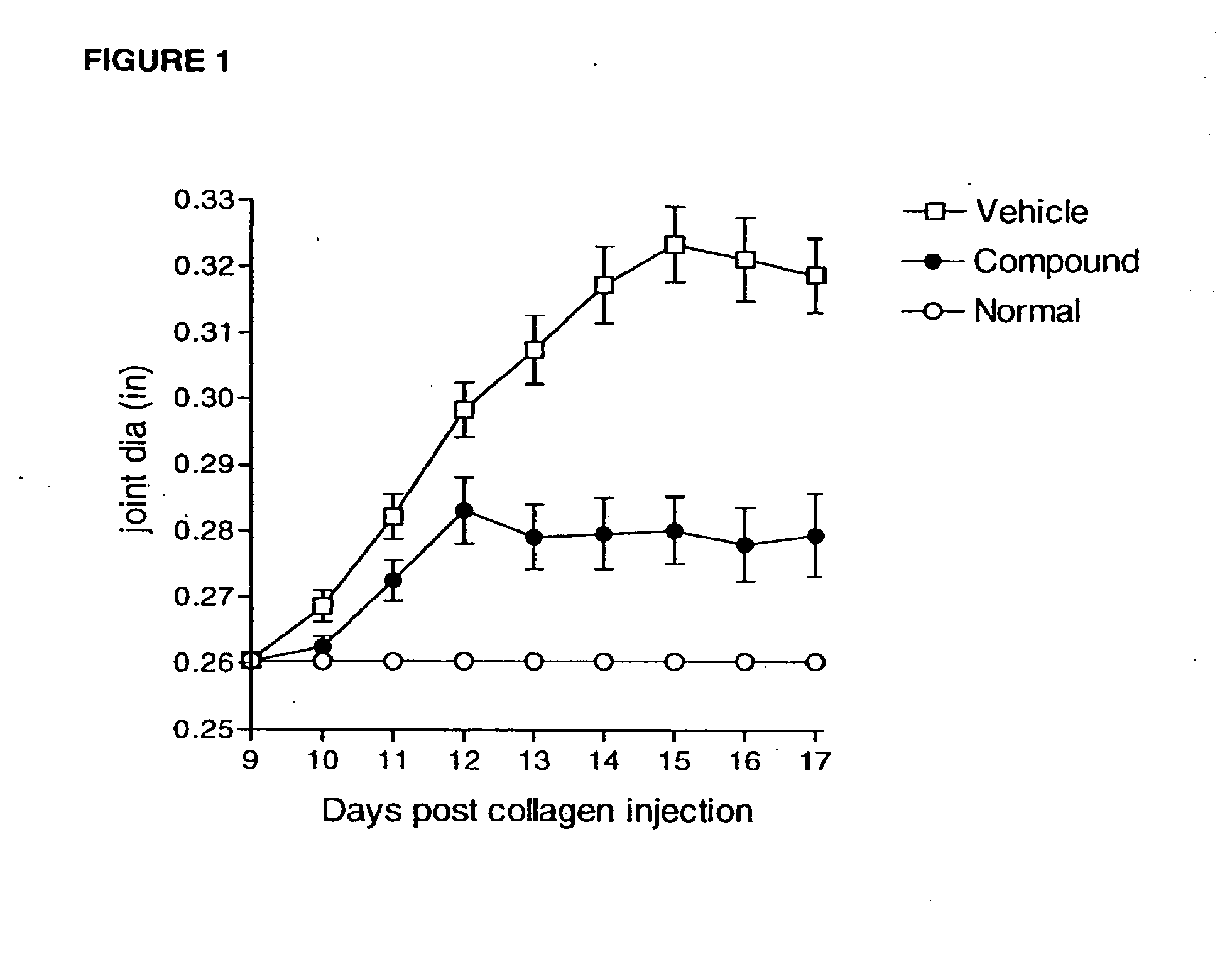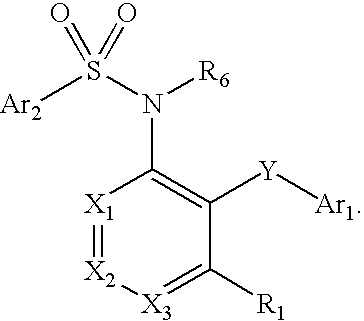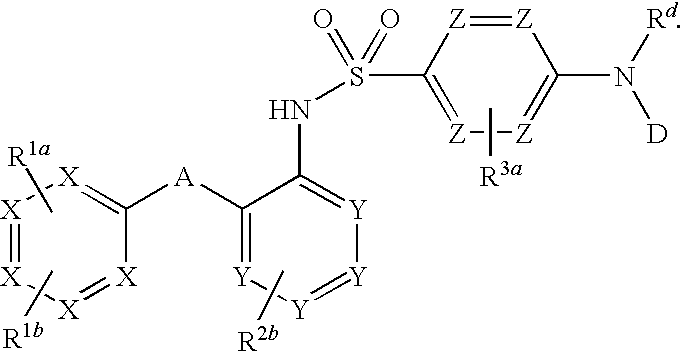Ccr2 inhibitors and methods of use thereof
a technology of ccr2 and inhibitors, applied in the field of compounds, can solve the problems of reducing food intake and attenuating the development of obesity in mice, and achieve the effects of modulating chemokine activity and chemokine function
- Summary
- Abstract
- Description
- Claims
- Application Information
AI Technical Summary
Benefits of technology
Problems solved by technology
Method used
Image
Examples
example 1
4-Chloro-N-(5-chloro-2-phenoxy-phenyl)-3-trifluoromethyl-benzenesulfonamide
[0834]
[0835]To a solution of 5-chloro-2-phenoxy-phenylamine (75 mg, 0.34 mmol) in anhydrous pyridine (0.5 mL) was added drop wise a solution of 4-chloro-3-trifluoromethyl-benzenesulfonyl chloride (95 mg, 0.341 mmol) in pyridine (0.5 mL). The resulting mixture was stirred at room temperature for 2 h. The reaction mixture was separated by preparative HPLC (20→80% gradient of ACN-water) and pure product fractions were lyophilized to provide pure product as a solid. 1H NMR (400 MHz, CDCl3) δ 8.04 (d, J=2.0 Hz, 1H), 7.80 (dd, J=8.4, 2.0 Hz, 1H), 7.70 (d, J=2.4 Hz, 1H), 7.51 (d, J=8.4 Hz, 1H), 7.27-7.23 (m, 2H), 7.14-7.10 (m, 1H), 7.05-7.02 (m, 2H), 6.66 (d, J=8.4 Hz, 1H), 6.60-6.56 (m, 2H). MS m / z: 484.0 (M+Na).
example 2
3,4-Dichloro-N-[5-chloro-2-(morpholine-4-carbonyl)phenyl]benzenesulfonamide
[0836]
[0837]To a mixture of 4-chloro-2-(3,4-dichlorobenzenesulfonylamino)-benzoic acid (21 mg), morpholine (10 mg) and N,N-diisopropylethylamine (0.019 mL) in CH2Cl2 (1.5 mL) was added 1-propanephosphonic acid cyclic anhydride (50% in ethyl acetate, 0.024 mL). After four hours the reaction mixture was directly purified via flash column (65% ethyl acetate in hexane) to afford 14 mg of 3,4-dichloro-N-[5-chloro-2-(morpholine-4-carbonyl)phenyl]benzenesulfonamide as a pure white powder. 1H-NMR (400 MHz, CDCl3): δ 7.86 (d, 1H), 7.67-7.60 (m, 2H), 7.36 (m, 1H), 7.14 (m, 1H), 6.72 (m, 1H), 3.71 (m, 4H), 3.12 (m, 4H). MS: (M+H) / z=451.2.
example 3
3,4-Dichloro-N-[2-(2-oxazolyl-5 chlorophenyl]benzenesulfonamide
[0838]
[0839]To an ice-water cooled solution of 2-(4-chloro-2-aminophenyl)-1,3-oxazole (97 mg, 0.5 mmol) in pyridine (1.0 mL) was added 3,4-dichlorobenzenesulfonylchloride (123 mg, 0.5 mmol) in pyridine (0.5 mL). The mixture was stirred at room temperature for 3 hours. The mixture was directly purified via Prep HPLC to give 3,4-dichloro-N-[2-(2-oxazolyl-5 chlorophenyl]benzenesulfonamide as a white powder. 1H-NMR (400 MHz, CDCl3): δ 7.94 (s, 1H), 7.85 (d, J=1.6 Hz, 1H), 7.75 (s, 1H), 7.70 (s, 1H), 7.64 (m, 1H), 7.48 (m, 1H), 7.30 (s, 1H), 7.10 (d, 1H). MS: (M+H) / z=405.
PUM
| Property | Measurement | Unit |
|---|---|---|
| Volume | aaaaa | aaaaa |
| Volume | aaaaa | aaaaa |
| Molar density | aaaaa | aaaaa |
Abstract
Description
Claims
Application Information
 Login to View More
Login to View More - R&D
- Intellectual Property
- Life Sciences
- Materials
- Tech Scout
- Unparalleled Data Quality
- Higher Quality Content
- 60% Fewer Hallucinations
Browse by: Latest US Patents, China's latest patents, Technical Efficacy Thesaurus, Application Domain, Technology Topic, Popular Technical Reports.
© 2025 PatSnap. All rights reserved.Legal|Privacy policy|Modern Slavery Act Transparency Statement|Sitemap|About US| Contact US: help@patsnap.com



